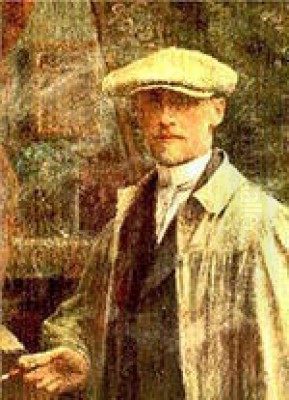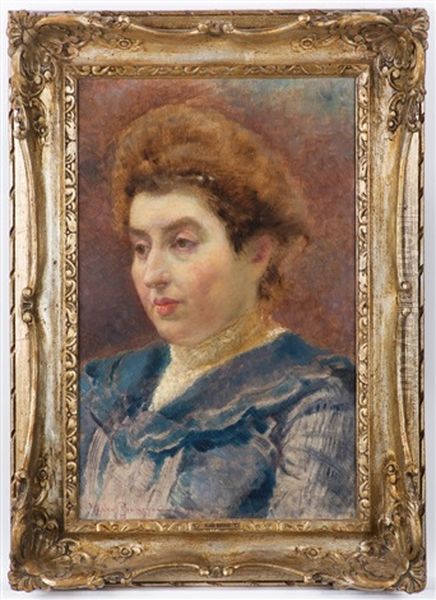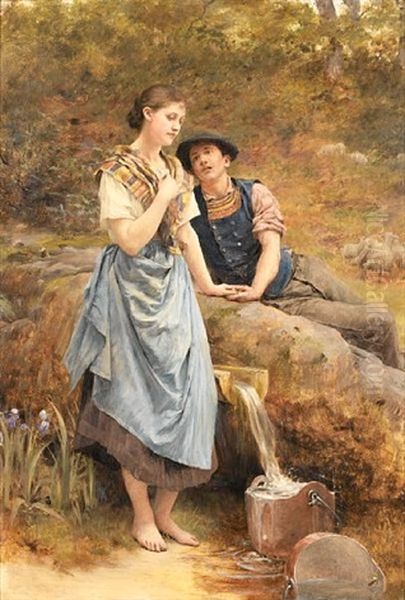
Vlaho Bukovac stands as one of Croatia's most celebrated painters, a pivotal figure whose artistic journey navigated the transition from 19th-century academic traditions to the burgeoning modernism of the early 20th century. Born Biagio Faggioni in Cavtat, near Dubrovnik, on July 4, 1855, his life was a tapestry of international experiences, diverse artistic influences, and a profound dedication to his craft and the cultural development of his homeland. His legacy is marked by a prolific output, a distinctive stylistic evolution, and a significant role as an educator and cultural catalyst.
Early Life and Formative Experiences
Bukovac's early years were characterized by hardship and adventure. His father, an Italian, and his Croatian mother provided him with a mixed heritage that would later resonate in his cosmopolitan artistic outlook. The family's modest means meant that formal education was a luxury. At the tender age of eleven, seeking better prospects, he journeyed to the United States with an uncle. However, this American sojourn was cut short. A fall and subsequent injury sustained while working on a ship sailing between Istanbul, Odessa, and Liverpool forced his return to the Dubrovnik region.
These early experiences, though challenging, undoubtedly shaped his resilient character and perhaps fueled his artistic imagination. The diverse cultures and landscapes he encountered, however briefly, may have sown the seeds for his later explorations of varied themes and styles. Back in Dalmatia, his innate talent for drawing began to surface more prominently, attracting local attention and setting him on a path, albeit an unconventional one, towards an artistic career.
The Parisian Crucible: Education and Emergence
The turning point in Bukovac's artistic development came in 1877 when, with the crucial support of patrons such as the writer Medo Pucić and Bishop Josip Juraj Strossmayer, a key figure in Croatian cultural and political life, he was able to travel to Paris. This was the undisputed art capital of the world, and for an aspiring painter, it was the ultimate destination. Bukovac enrolled in the prestigious École des Beaux-Arts, the bastion of academic art.

His primary mentor at the École was Alexandre Cabanel, a highly respected and influential academic painter, famous for works like The Birth of Venus and portraits of Napoleon III. Cabanel's studio was a hub for traditional artistic training, emphasizing meticulous draughtsmanship, classical composition, and a polished finish. Bukovac absorbed these lessons diligently, mastering the technical skills that would form the bedrock of his art. Other prominent academic artists of the era, such as Jean-Léon Gérôme and William-Adolphe Bouguereau, also epitomized the prevailing Salon taste, against which Impressionism was then a radical counter-movement.
Bukovac made his debut at the highly competitive Paris Salon in 1878, a significant achievement for any young artist. He continued to exhibit there regularly for sixteen years. His early Parisian works often displayed a "sugary" realism, as some critics termed it, catering to the popular tastes of the time. A notable success came in 1882 with his painting La Grande Iza (The Great Iza), which earned him an honorable mention at the Salon and solidified his reputation.
Navigating the Currents of Parisian Art
Paris in the late 19th century was a vibrant, dynamic artistic environment, a melting pot of established traditions and revolutionary new ideas. While Bukovac was schooled in the academic style of Cabanel, he was not immune to the seismic shifts occurring in the art world. Impressionism, championed by artists like Claude Monet, Edgar Degas, and Pierre-Auguste Renoir, had already challenged the Salon's dominance with its emphasis on capturing fleeting moments, the effects of light and color, and contemporary life.
Bukovac, with his keen observational skills and adaptable nature, began to incorporate elements from these newer movements into his work. His palette lightened, his brushwork became looser and more expressive, and he showed an increasing interest in the play of light. This period demonstrates his capacity to synthesize different approaches, blending the solid grounding of his academic training with the fresh perspectives of Impressionism and, later, Symbolism. Figures like Gustave Moreau and Odilon Redon were exploring the inner world of dreams and mythology, and these Symbolist undercurrents also found their way into Bukovac's evolving aesthetic.
He traveled extensively during his Parisian years, undertaking commissions in England and even revisiting America. These journeys broadened his horizons and exposed him to different artistic tastes and patronage systems, further enriching his artistic vocabulary.
Masterpiece and Maturation: Une fleur

One of Bukovac's most iconic and discussed works from his Parisian period is the 1887 nude painting titled Une fleur (A Flower). This piece, depicting a reclining female nude in a lush, suggestive setting, caused a considerable stir in both Paris and Croatia. It showcased his mastery of the human form, a hallmark of academic training, but also imbued the subject with a sensuality and a modern sensibility that pushed beyond conventional Salon nudes.
Une fleur exemplifies Bukovac's ability to blend technical virtuosity with a more contemporary, almost Impressionistic handling of light and color in the surrounding environment. The painting's success cemented his reputation as a skilled painter of the female form, a subject he would return to throughout his career. His portraiture also flourished during this time, as he captured the likenesses of numerous prominent individuals, demonstrating psychological insight alongside technical skill.
Return to Croatia: The Zagreb Years and Cultural Leadership
In 1893, after a successful and formative period in Paris, Bukovac made the significant decision to return to Croatia, settling in Zagreb. This move marked a new chapter in his life and career, one where he would play a pivotal role in the development of Croatian modern art. Zagreb, at the time, was experiencing a cultural awakening, and Bukovac, with his international experience and reputation, became a central figure in its burgeoning art scene.
He quickly became a leader in many important cultural and artistic activities. In the same year of his return, 1893, he organized Zagreb's first significant art exhibition, a landmark event that introduced many Croatians to contemporary European artistic trends and showcased local talent. He was instrumental in advocating for and eventually helping to establish an art pavilion in Zagreb, providing a dedicated space for exhibitions.
During his Zagreb period, Bukovac's style continued to evolve. He introduced a brighter palette, often associated with plein-air painting and Impressionistic influences, to the local art scene. This was a significant departure from the darker, more academic tones that had previously dominated Croatian painting. He became a mentor and an inspiration to a younger generation of Croatian artists, including figures like Mato Celestin Medović and Bela Čikoš Sesija, who were themselves key in shaping Croatian modernism.
In 1897, Bukovac founded the Croatian Artists' Association (Društvo hrvatskih umjetnika), a crucial institution that aimed to promote Croatian art and artists, organize exhibitions, and foster a sense of national artistic identity. This was a period of intense activity and influence for Bukovac.
International Recognition and National Representation

Bukovac's efforts to promote Croatian art extended beyond national borders. A significant moment came in 1896 with the Budapest Millennium Exhibition, celebrating a thousand years of the Hungarian state. Croatia, then part of the Austro-Hungarian Empire, had its own pavilion, and Bukovac was a key organizer and exhibitor. His works were well-received, and the Croatian presence at such a major international event was a statement of cultural sovereignty and artistic vitality.
His international exposure continued with his participation in the Venice Biennale, where he first exhibited in 1897. The Biennale was rapidly becoming one of the most prestigious international art exhibitions, and Bukovac's inclusion further enhanced his standing and brought Croatian art to a wider European audience.
Despite his successes in Zagreb, his tenure there was not without its challenges. A notable dispute arose with Izidor (Iso) Kršnjavi, an influential painter, art historian, and politician who played a significant role in Croatian cultural policy. The exact nature of their disagreement is complex, likely involving artistic differences and perhaps personal or political rivalries. This conflict eventually contributed to Bukovac's decision to leave Zagreb.
The Cavtat Interlude and a Shift in Focus
Around 1898, following the tensions in Zagreb, Bukovac returned to his native Cavtat. This period marked a shift in his artistic focus. While he continued to paint, his style in Cavtat often showed a more intimate, pointillist-influenced approach, particularly in his landscapes and depictions of local life. He explored new ways of rendering light and color, breaking down forms into small dabs of paint, reflecting an ongoing engagement with Post-Impressionist techniques.
The return to the familiar Mediterranean environment of his childhood seems to have offered him a period of reflection and stylistic experimentation. The vibrant light and colors of the Dalmatian coast found expression in works that were often more personal and less monumental than his grand Salon pieces or his Zagreb-era public commissions.
The Prague Period: A New Academic Chapter
In 1903, Bukovac embarked on another significant international move, accepting a professorship at the prestigious Academy of Fine Arts in Prague. This marked the final major phase of his career. In Prague, he was highly respected as an educator, influencing a new generation of Czech artists. His own work during this period often focused on portraiture, a genre in which he had always excelled.
His Prague portraits are characterized by their refined technique, psychological depth, and often a subtle, elegant color palette. He continued to receive commissions and exhibit his work. The artistic environment in Prague, with its own rich traditions and burgeoning modern movements, including the rise of Czech Cubism and Art Nouveau (with figures like Alfons Mucha achieving international fame), provided a stimulating context for his later years.
His connection to Prague remained strong. After his death, a posthumous exhibition of his works was organized in the city by the artist Jan Bednář, attesting to the esteem in which he was held. Sadly, Bukovac's later years were reportedly marked by deteriorating mental health, a poignant end to a vibrant and productive life.
Bukovac's Evolving Artistic Style: A Synthesis
Vlaho Bukovac's artistic style is notable for its evolution and its synthesis of diverse influences. He began firmly rooted in the academic tradition of Alexandre Cabanel, mastering draughtsmanship and classical composition. His early Salon works reflect this training, with their polished finish and often historical or allegorical subjects.
However, his exposure to Impressionism in Paris led to a significant lightening of his palette, a looser brushstroke, and a greater concern for capturing the effects of light and atmosphere. This is evident in many of his portraits and genre scenes from the mid-to-late Parisian period and particularly during his Zagreb years, where he introduced these "modern" elements to Croatian art.
The Cavtat period saw him experiment with Pointillist techniques, using small, distinct dots or dabs of color to create vibrant, luminous surfaces, especially in his landscapes. This demonstrates his ongoing engagement with contemporary European artistic developments.
Throughout his career, Symbolist undertones can also be detected in some of his works, particularly in allegorical compositions or those with a more poetic or enigmatic quality. His nudes, while grounded in academic skill, often possess a sensuality and psychological charge that aligns with Symbolist sensibilities.
Ultimately, Bukovac was not a dogmatic follower of any single movement. Instead, he skillfully wove together elements from Realism, Impressionism, Pointillism, and Symbolism, all underpinned by his strong academic foundation. His ability to adapt and integrate these varied influences, while maintaining a distinctive personal vision, is a key characteristic of his art. He was a master colorist, and his paintings are often celebrated for their vibrant hues and sophisticated handling of light.
Notable Works Revisited
Beyond Une fleur (1887) and La Grande Iza (1882), Bukovac's oeuvre is vast and varied. His large-scale historical and allegorical compositions, such as Gundulić's Dream (1894), which decorated the curtain of the Croatian National Theatre in Zagreb, demonstrate his ambition and skill in complex, multi-figure compositions.
His numerous portraits, including Self-portrait with Captain's Hat and sensitive depictions like Portrait of a Daughter, reveal his ability to capture not only a physical likeness but also the personality and inner life of his sitters. His landscapes, particularly those from his Cavtat period, are celebrated for their luminous quality and innovative technique. He also painted religious scenes and decorative panels, showcasing his versatility.
Legacy and Enduring Influence
Vlaho Bukovac passed away in Prague on April 23, 1922. He left behind a rich and complex artistic legacy. He is widely regarded as one of the most important Croatian painters, a key figure in the modernization of Croatian art at the turn of the 20th century. His introduction of a lighter palette and Impressionistic techniques had a profound impact on the generation of artists who followed him in Croatia.
As an educator, both informally in Zagreb and formally as a professor in Prague, he influenced many aspiring artists. His role in founding the Croatian Artists' Association and his efforts to promote Croatian art on the international stage were crucial for the development of a national artistic identity.
His work is held in major museums and private collections across Croatia and Europe. Retrospectives of his art continue to attract significant public interest, reaffirming his status as a master. Bukovac's life and career exemplify the journey of an artist navigating a period of profound artistic change, successfully bridging the gap between the 19th-century academic tradition and the emerging currents of modernism. He remains a testament to the power of talent, resilience, and an unwavering dedication to artistic expression. His ability to absorb diverse influences while forging a unique path makes him a fascinating and enduring figure in the history of European art.